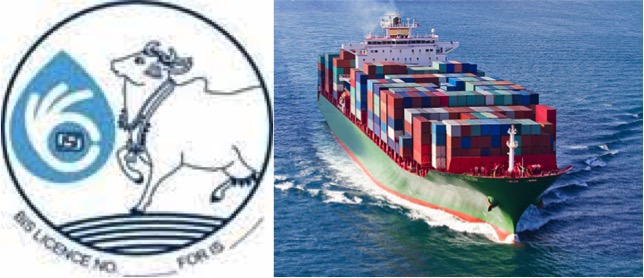For India’s dairy sector, December 23, 2021, was a landmark day. On this day the Bureau of Indian Standards (BIS) with the help of National Dairy Development Board (NDDB) issued a unified system for quality and safety of milk and dairy products across the country. The integrated logo of Kamdhenu Cow – a seal of certified quality, is the first ever move by India to bring uniformity in milk quality and certify end-to-end milk value-chain.
The move benefits not only dairy consumers, but also milk producers who will get greater access to international markets and look forward to better price realisations.
India’s policy thrust in dairy has been to cement the country’s numero uno position in milk production as well as make it one of the top global dairy exporting nations. Currently, exports lag.
Rising shipments
Since 2014, when India exported just 66,424 tonnes of dairy products, there has been a 78 per cent jump in shipments abroad. It is still a tiny fraction of India’s annual milk production (195 million tonnes of milk in 2020) though.
What has held back India’s dairy exports is quality issues and lack of value-addition. Conventionally Skimmed Milk Powder (SMP)/ Whole Milk Powder dominated India’s dairy export pack with nearly 35 per cent share in the overall dairy products exports. But this could change in the coming years.
RS Sodhi, Managing Director, Gujarat Cooperative Milk Marketing Federation (GCMMF), believes that Amul’s exports are set to rise by 70-80 per cent this year and the overseas market is getting attractive for other players too. “India is becoming a big force. Earlier, SMP was the main commodity of exports. Now our dairy fats are also becoming competitive,” Sodhi said.
Consumption push
The year gone by, 2021, saw significant push in consumer demand for dairy products. Regardless of the 10-12 per cent demand destruction in the hotels, restaurants and caterers and events segment, dairy consumption saw robust uptick with the retail consumer segment picking up. “In the past two years, milk inflation was barely 2 per cent annually, as against about 25 per cent jump in prices of edible oils and other protein/fat sources. So lower price conditions in milk supported demand with exponential growth in the past two years,” Sodhi said.
Prices to go up
But the dairy farmers didn’t gain much in 2021. Their realisations from milk and milk products did not increase despite higher input costs. Due to the demand-supply factors, the farm-gate price of milk didn’t lift even as the input costs shot up. “ What they have lost in 2021, has to be compensated in 2022. So, we expect dairy producers to pass on the cost pressure and there would be some increase in prices matching the input costs,” said Sodhi.
Investments to flow
Meanwhile, as dairy consumption grows – in domestic and international markets – the prospects get brighter for higher realisations, increased processing and better margins. This will encourage the private sector to invest more in processing capacities as well as in equipment and infrastructure. For example, India’s performance-linked incentive (PLI) scheme could create global dairy export giants in India.
2022 will also see dairy sector’s transformation being fuelled by Centre’s Dairy Investment Accelerator, which will help channelise the ₹15,000-crore Animal Husbandry Infrastructure Development Fund (AHIDF) for desired goals such as dairy processing and related value-addition infrastructure, etc.
Source : The Outreach Dec 27 2021

